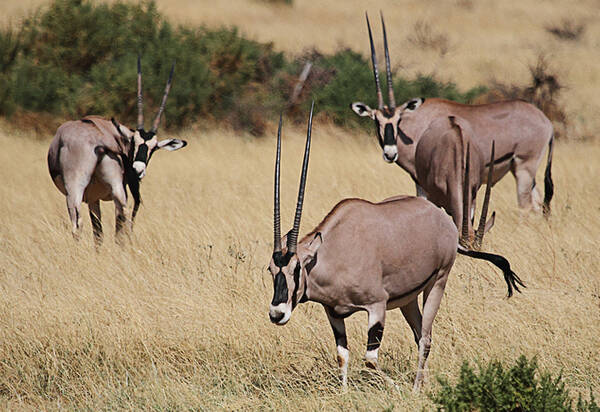Oryx gazella
IUCN
LCBasic Information
Scientific classification
- name:Oryx gazella
- Scientific Name:Oryx gazella,Gemsbok,Gemsbok
- Outline:Ungulata
- Family:Artiodactyla Bovidae Oryx
Vital signs
- length:190-210cm
- Weight:210-240kg
- lifetime:18-22years
Feature
It is the largest species in the genus Oryx.
Distribution and Habitat
The South African Oryx is found in Botswana, Namibia, South Africa, and Zimbabwe.
Possibly extinct: Angola.
The South African Oryx lives in hot, dry environments all year round. It lives at altitudes of 900-1200 meters, and can live in wooded rainy grasslands and prairies, as well as dry grasslands and desert areas. It prefers rocky plains with limited rainfall, and also occurs in sand dunes and rocky mountainous areas.
Appearance
The South African oryx is the largest of the four oryx species, with a body length of about 190-210 cm and a shoulder height of about 110-130 cm. It weighs about 210-240 kg and is the largest species in the genus Oryx. Both males and females have long and straight horns. The difference from most antelopes is that the horns of males and females are very similar, and the ends of the long horns are sharp like swords, so it is called "oryx". Among them, the horns of males are larger, and the longest can reach about 120 cm.
The whole body is blue-gray, and the hair on the body is gray-brown, but the hair on the face, abdomen and lower limbs is white, except for a black stripe on the upper limbs, the outside of the abdomen and the back. Its black and white face is also a more striking physiological feature. There is black hair in the center of the face, around the eyes to the mouth, the pharynx, the sides of the body between the forelimbs and hind limbs, the tibia of the limbs a
Details
South African Oryx gazella (scientific name: Oryx gazella) is also known as Gemsbok in foreign languages. It has 4 subspecies.

South African oryx live in groups, with 6-40 individuals in each group, with an average of 14 and a record of more than 300. The group is centered on a powerful adult male oryx, which leads several female oryxes and young oryxes to live together. The territory covers an area of about 25 square kilometers, and adult males will leave the group to live alone. It is active at dawn and dusk, and hides in the shade to rest when the temperature is high during the day. As a herbivorous animal, its main food is grass and leaves. When the conditions are difficult, it can use its strong forelimbs to dig out plant roots 1 meter deep underground to satisfy its hunger.
Like several other large antelopes in its genus, the South African oryx is very drought-resistant. Due to living in a hot and dry environment for many years, the South African oryx has evolved a variety of physiological characteristics to adapt to the desert environment. When it lacks water, it can go without drinking for several days. In order to retain the precious water in its body, it can raise its body temperature from 35.7℃ to 45℃, a temperature that other mammals would definitely die at, reducing the temperature difference between the body and the outside world, and reducing the absorption of heat to a certain extent. It is very adapted to survival in the desert.

South African oryx mates and reproduces between December and March of the following year. During this period, fierce battles for mates will break out between male oryxes. Both sides will use their sharp horns to stab each other to a bloody mess in order to compete for the opportunity to reproduce with a female. The gestation period of female oryxes is about 9-10 months. Usually there is only one calf per litter, and occasionally two calves. The calves are born between September and January of the following year and can participate in group activities 3-6 weeks after birth. The lactation period is about 3-4 months. They can live independently at 5 months old. Females are sexually mature at around 2 years old, and males are 5 years old. The life span is 18-22 years.
Listed in the 2012 Red List of Endangered Species of the World Conservation Union (IUCN) ver 3.1 - Least Concern (LC).
Protect wild animals and stop eating game.
Maintaining ecological balance is everyone's responsibility!








